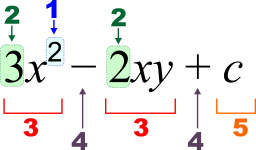Algebraic expression
In mathematics, an algebraic expression is an expression built up from integer constants, variables, and the algebraic operations (addition, subtraction, multiplication, division and exponentiation by an exponent that is a rational number).[1] For example, 3x2 − 2xy + c is an algebraic expression. Since taking the square root is the same as raising to the power 1/2,
is also an algebraic expression.
By contrast, transcendental numbers like π and e are not algebraic, since they are not derived from integer constants and algebraic operations. Usually, Pi is constructed as a geometric relationship, and the definition of e requires an infinite number of algebraic operations.
A rational expression is an expression that may be rewritten to a rational fraction by using the properties of the arithmetic operations (commutative properties and associative properties of addition and multiplication, distributive property and rules for the operations on the fractions). In other words, a rational expression is an expression which may be constructed from the variables and the constants by using only the four operations of arithmetic. Thus,
is a rational expression, whereas
is not.
A rational equation is an equation in which two rational fractions (or rational expressions) of the form
are set equal to each other. These expressions obey the same rules as fractions. The equations can be solved by cross-multiplying. Division by zero is undefined, so that a solution causing formal division by zero is rejected.
Terminology
Algebra has its own terminology to describe parts of an expression:

1 – Exponent (power), 2 – coefficient, 3 – term, 4 – operator, 5 – constant, - variables
In roots of polynomials
The roots of a polynomial expression of degree n, or equivalently the solutions of a polynomial equation, can always be written as algebraic expressions if n < 5 (see quadratic formula, cubic function, and quartic equation). Such a solution of an equation is called an algebraic solution. But the Abel–Ruffini theorem states that algebraic solutions do not exist for all such equations (just for some of them) if n 5.
Conventions
Variables
By convention, letters at the beginning of the alphabet (e.g. ) are typically used to represent constants, and those toward the end of the alphabet (e.g. and ) are used to represent variables.[2] They are usually written in italics.[3]
Exponents
By convention, terms with the highest power (exponent), are written on the left, for example, is written to the left of . When a coefficient is one, it is usually omitted (e.g. is written ).[4] Likewise when the exponent (power) is one, (e.g. is written ),[5] and, when the exponent is zero, the result is always 1 (e.g. is written , since is always ).[6]
Algebraic and other mathematical expressions
The table below summarizes how algebraic expressions compare with several other types of mathematical expressions by the type of elements they may contain, according to common but not universal conventions.
A rational algebraic expression (or rational expression) is an algebraic expression that can be written as a quotient of polynomials, such as x2 + 4x + 4. An irrational algebraic expression is one that is not rational, such as √x + 4.
See also
- Algebraic equation
- Algebraic function
- Analytical expression
- Arithmetic expression
- Closed-form expression
- Expression (mathematics)
- Precalculus
- Polynomial
- Term (logic)
Notes
- Morris, Christopher G. (1992). Academic Press dictionary of science and technology. Gulf Professional Publishing. p. 74.
algebraic expression over a field.
- William L. Hosch (editor), The Britannica Guide to Algebra and Trigonometry, Britannica Educational Publishing, The Rosen Publishing Group, 2010, ISBN 1615302190, 9781615302192, page 71
- James E. Gentle, Numerical Linear Algebra for Applications in Statistics, Publisher: Springer, 1998, ISBN 0387985425, 9780387985428, 221 pages, [James E. Gentle page 183]
- David Alan Herzog, Teach Yourself Visually Algebra, Publisher John Wiley & Sons, 2008, ISBN 0470185597, 9780470185599, 304 pages, page 72
- John C. Peterson, Technical Mathematics With Calculus, Publisher Cengage Learning, 2003, ISBN 0766861899, 9780766861893, 1613 pages, page 31
- Jerome E. Kaufmann, Karen L. Schwitters, Algebra for College Students, Publisher Cengage Learning, 2010, ISBN 0538733543, 9780538733540, 803 pages, page 222
References
- James, Robert Clarke; James, Glenn (1992). Mathematics dictionary. p. 8.